Canada's balance of international payments, third quarter 2012
Archived Content
Information identified as archived is provided for reference, research or recordkeeping purposes. It is not subject to the Government of Canada Web Standards and has not been altered or updated since it was archived. Please "contact us" to request a format other than those available.
Related subjects
-
[an error occurred while processing this directive]
Canada's current account deficit (on a seasonally adjusted basis) increased $0.5 billion to $18.9 billion in the third quarter, as the deficit on trade in goods expanded further. This increase was attributable to a larger decline in exports than imports.
Foreign investment in Canadian securities and current account balance
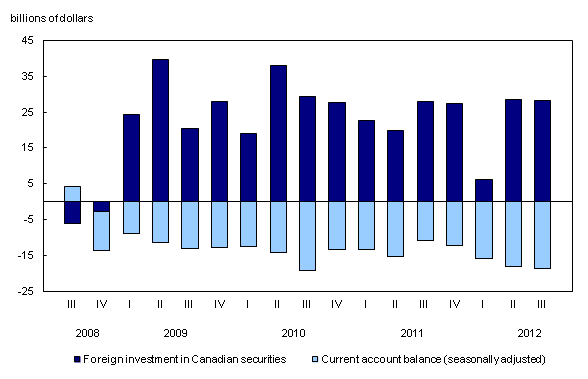
Chart description: Foreign investment in Canadian securities and current account balance
In the financial account (unadjusted for seasonal variation), non-resident investors added Canadian securities to their holdings for a 15th straight quarter, a period largely coinciding with the re-emergence of Canada's current account deficit. However, stronger Canadian direct investment abroad moderated the overall net inflow of funds to the Canadian economy over the quarter.
Current account
Deficit on goods increases further
The balance on trade in goods posted a $4.8 billion deficit in the third quarter, following a $3.6 billion deficit in the previous quarter. Exports were down with reductions in a number of commodities in the quarter, led by energy. Canada's trade surplus with the United States declined $0.6 billion, as exports were down $2.4 billion and imports were down $1.8 billion.
Current account balances
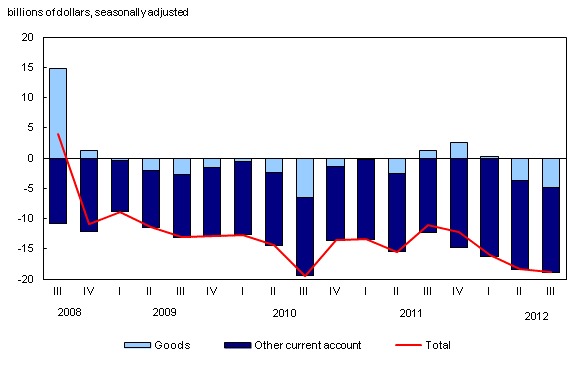
Chart description: Current account balances
Total exports of goods were down $3.7 billion to $112.7 billion. This marked the third consecutive quarterly reduction in the value of goods exported. Each of the 13 principal categories of goods either declined or was unchanged in the third quarter. Exports of energy products were down $1.6 billion, on lower volumes of crude petroleum and refined petroleum products. Notable reductions were posted by consumer goods (-$0.6 billion), as a result of reduced volumes, and by industrial chemical products (-$0.4 billion), as a result of lower prices.
Imports of goods declined $2.5 billion in the third quarter, following the high set in the previous quarter. Motor vehicles and parts fell $0.7 billion and energy products declined $0.5 billion. Motor vehicles and parts imports reflected lower volumes and prices, while energy product imports were reduced by lower prices. Except for farm, fishing and food products, other major import categories were either lower or unchanged in the quarter.
Goods balances by geographic area
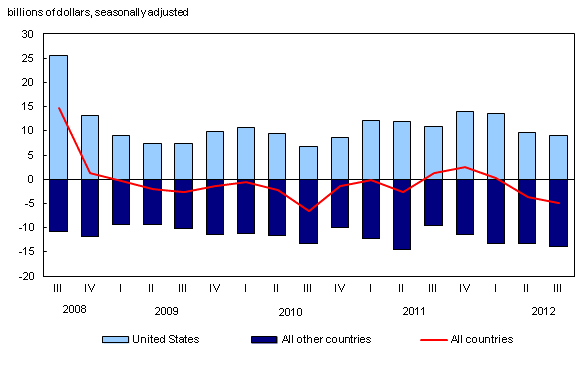
Chart description: Goods balances by geographic area
Deficit for trade in services reaches a new high
The deficit on trade in services widened $0.3 billion in the third quarter to a high of $6.3 billion, just above the previous high set in the second quarter of 2011. The deficit on transportation services increased $0.3 billion in the third quarter, as payments on water and air transport increased and receipts on water and air transport decreased. The international travel deficit narrowed $0.1 billion to $4.6 billion. That deficit was supported by sustained strong expenditure by Canadians travelling in the United States. The surplus on trade in commercial services edged down in the quarter on lower imports and exports.
Investment income deficit narrows
The deficit on investment income fell $1.2 billion in the third quarter to $6.3 billion. Income of Canadian direct investors was up $0.4 billion, mainly on higher undistributed earnings on foreign operations. Interest and dividends received by Canadians on their investment in foreign securities were up slightly. Income accruing to non-residents on their direct investment in Canada was down $0.7 billion on lower undistributed profits of their Canadian subsidiaries. This decline was partly offset by higher dividends received by non-residents on their holdings of Canadian equity securities.
Financial account
Foreign investors continue to accumulate Canadian securities
Non-residents acquired $28.2 billion of Canadian securities in the third quarter, mainly focused in debt securities. This acquisition was on par with the level of investment in the last quarter. However, purchases of Canadian securities by non-residents in the third quarter were partially offset by higher investment in foreign equities by residents. The third quarter marked the 15th straight quarterly net foreign investment in Canadian securities. Since the first quarter of 2009, investment from abroad has been primarily focused in Canadian debt securities.
Foreign investment in Canadian securities
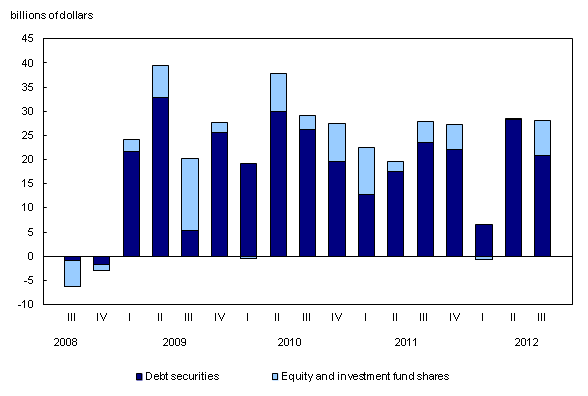
Chart description: Foreign investment in Canadian securities
Foreign investment in Canadian bonds was $19.9 billion and was led by Canadian government bonds purchased on the secondary market, mainly focused in shorter-term instruments. Investment in federal bonds at $9.5 billion was robust for a fourth straight quarter. Foreign investors purchased $0.9 billion of Canadian paper, down from $10.2 billion in the second quarter. In particular, non-residents divested Treasury bills in the third quarter, after acquiring large amounts in the previous quarter.
Non-resident investors added $7.3 billion of Canadian stocks to their holdings, the largest investment since the first quarter of 2011. Inflows reflected both foreign purchases of Canadian stocks on the secondary market and new issues of Canadian shares resulting from cross-border merger and acquisition activity. Canadian stock prices were up 6.2% in the quarter and the Canadian dollar appreciated against its US counterpart.
Canadian investment in foreign securities highest in more than three years
Canadian investment in foreign securities advanced to $8.9 billion in the third quarter, led by equities. Investment in foreign equities was $6.2 billion and was focused in the US stock market. US stock prices gained 5.8% to reach, by quarter-end, levels last seen at the end of 2007. This was the largest such activity since the first quarter of 2009, a period characterized by relatively low stock prices following the financial crisis.
Canadian investors added $2.7 billion of foreign debt securities to their portfolios, mainly US corporate bonds. Canadian investment in maple bonds was modest in the quarter despite an increase in new issue activity in September, largely offset by retirements in July.
Outward direct investment more than double inward direct investment
Canadian direct investment abroad was $19.1 billion in the third quarter, the largest such outflow since the fourth quarter of 2010. Cross-border mergers and acquisitions accounted for $9.6 billion of the overall outflow after three quarters of more moderate activity. The finance and insurance sector as well as the holding companies sector together accounted for half of Canadian direct investment abroad in the quarter.
Canadian direct investment abroad
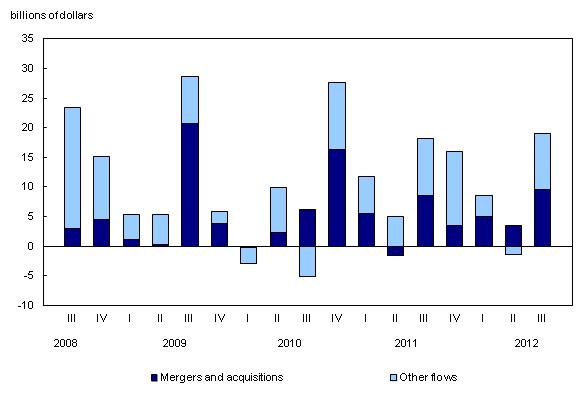
Chart description: Canadian direct investment abroad
Foreign direct investment in Canada was virtually unchanged, at $8.4 billion in the third quarter. Earnings reinvested in Canadian affiliates by foreign direct investors accounted for most of the activity. The bulk of foreign direct investment in Canada was from European and US investors. Inward mergers and acquisitions activity were subdued for a second straight quarter.
Note to readers
The balance of international payments covers all economic transactions between Canadian residents and non-residents in three accounts: the current account, the capital account, and the financial account.
The current account covers transactions in goods, services, compensation of employees, investment income and current transfers.
The current account data in this release are seasonally adjusted. For more information on seasonal adjustment, see Seasonal adjustment and identifying economic trends.
The capital account covers capital transfers and transactions in non-produced non-financial assets.
The financial account comprises transactions in financial assets and liabilities.
In principle, a net lending (+) / net borrowing (-) derived from the sum of the current and capital accounts corresponds to a net lending (+) / net borrowing (-) derived from the financial account. In practice, as data are compiled from multiple sources, this is rarely the case and gives rise to measurement error. The discrepancy (net errors and omissions) is the unobserved net inflow or outflow.
The historical revision to the Canadian National Accounts was released in October 2012. Information on Canada's Balance of International Payments new CANSIM tables and output formats is available on the National economic accounts website. Data in this current release reflect conceptual, classification and presentational changes related to the historical revision. It also fully integrates the results of the redesigned quarterly investment survey and methodology updates.
For more information about the balance of payments, consult the "Frequently asked questions" section in the National economic accounts module of our website. The module also presents the most recent balance of payments statistics.
Available without charge in CANSIM: tables CANSIM table376-0012, CANSIM table376-0013, CANSIM table376-0101 to 376-0108, CANSIM table376-0121, CANSIM table376-0122 and CANSIM table376-0124.
Definitions, data sources and methods: survey numbers survey number1534, survey number1535, survey number1536 and survey number1537.
The balance of international payments data for the fourth quarter will be released on February 28, 2013.
For more information, contact us (toll-free 1-800-263-1136; infostats@statcan.gc.ca).
To enquire about the concepts, methods or data quality of this release, contact Denis Caron (613-951-1861; denis.caron@statcan.gc.ca) or Éric Boulay (613-951-1872; eric.boulay@statcan.gc.ca), Balance of Payments Division.
- Date modified:
